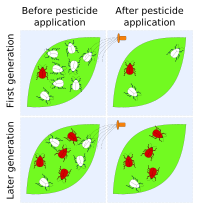
Photo from wikipedia
The tomato leafminer, Tuta absoluta, is one of the most destructive pests of tomato worldwide. Management of the pest is mainly based on chemical insecticides. Reliance on insecticides is difficult… Click to show full abstract
The tomato leafminer, Tuta absoluta, is one of the most destructive pests of tomato worldwide. Management of the pest is mainly based on chemical insecticides. Reliance on insecticides is difficult to sustain because of unintended long‐term adverse effects on the environment and human health. Consequently, there is a need to develop pest management strategies that ensure the production of high‐quality products, while at the same time ensuring environmental sustainability and maximum consumer protection. We evaluated the efficacy the biopesticides: Azadirachtin, Bacillus thuringiensis, Steinernema feltiae and Beauveria bassiana individually and in combination against T. absoluta under laboratory and greenhouse conditions. When second instar larvae were exposed to tomato leaf discs treated with Azadirachtin (3 g/L), B. thuringiensis (0.5 g/L) or B. bassiana (1.5 g/L), 70%–86%, 55%–65%, and 45.5%–58.5% mortality was observed, respectively. Steinernema feltiae (1,000 IJs/ml) was the least effective biopesticide, with 26%–42% mortality. In the greenhouse trials on tomato, pest infestation (mines/10 leaves/plant) and fruits damaged were significantly lower on plants treated with Azadirachtin + B. thuringiensis or Azadirachtin + B. bassiana compared to plants treated with Azadirachtin, B. thuringiensi, B. bassiana or S. feltiae alone. Azadirachtin + B. thuringiensis and Azadirachtin + B. bassiana resulted in 90% and 81% reduction in fruits damaged in the summer experiments, respectively, and 96% and 91% in winter. The most severe pest infestation was observed on plants treated with S. feltia. The results indicate that the biopesticides, except S. feltia, can contribute to T. absoluta control in greenhouse tomato crops. In particular, the combined use of Azadirachtin with B. thuringiensis or B. bassiana provided the highest level of control of the pest. The potential for including these biopesticides in an overall sustainable integrated pest management programme for T. absoluta is discussed.
Journal Title: Journal of Applied Entomology
Year Published: 2018
Link to full text (if available)
Share on Social Media: Sign Up to like & get
recommendations!